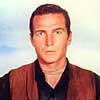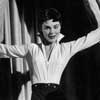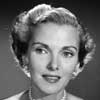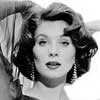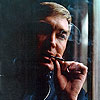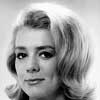| Last Update: 1/1/2009 | |
Page 3 of 6JO’D: Is that when you decided to get into modeling?
JO’D: And yet you have said that your modeling career didn’t really take off until you signed with an agent by the name of Anita Colby.
The years I worked for Anita Colby were a very exciting time in my life. The female models in those days were gorgeous! I would live several months in New York and then go back to L.A. to keep my toe in acting. Getting dropped when RKO closed didn’t bother me as much as I had feared because my modeling career took off right away. JO’D: Speaking of gorgeous models, one of the most beautiful in the 50s had to be Suzy Parker. Did you work with her?
JO’D: Your first photo shoot for Anita Colby was for Mutual of Omaha. What was that modeling experience like for you? BR: The ad was actually for Mutual of New York (MONY) and it was an exhilarating experience. I was a father returning home from work, being greeted by his two children and his wife. I remember Anita searched long and hard to find two children who resembled me and I thought the two youngsters she found, a brother and sister, did, in fact, look a lot like me. By the way, the cab driver in the shoot was a real cabbie. I remember he kept the meter in his cab running during the entire shoot! Insurance companies always budget commercial shoots very carefully, and it was cheaper to use a real cabdriver than to hire a model. JO’D: Please describe what a typical day in the life of a male model was like in the 1950s and 60s.
To show you how things sometimes went on these photo shoots, I was hired once to do an ad for Carlings Beer. It was shot in New York in the summer on an excruciatingly hot and muggy day. It was at a time when NY used to experience “brown outs” and during the shoot the air conditioning went off and wouldn’t come back on. The beer kept going flat with the heat and I was perspiring profusely in a wool Pendleton shirt. No matter how hard she tried, the makeup artist couldn’t keep me “powdered down”…beads of sweat kept popping out on my forehead and top lip. The beer may have gone flat, but I was frothing at the mouth! (laughs) They finally brought in a couple of fans. The beer was discarded and they wound up using creme soda in which they stirred in a little Rinso to get a nice head on the “beer”. (laughs) Just one of the tricks of the trade, and believe me, back then there were many! JO’D: Through your acting career in L.A., you met a lot of Hollywood performers. I know you were very close to the beautiful, Italian-Irish actress Gia Scala (The Guns of Navarone), who had an extremely difficult life.
Gia was childlike in some ways, and yet very sophisticated in others. She was a good actress and had some strong film roles until the early 1960s, when things began to go downhill for her. She was very well read and she painted beautifully. She was also a wonderful cook. Gia liked people and she trusted them. However, I believe her trust in some instances was misguided. I’ve missed her everyday since she died in April 1972.
JO’D: There’s been some controversy in recent times about the cause of Gia Scala’s death. Much of the information has been dispensed in interviews given by her sister, Tina Scotti (AKA Tina Scala). Would you like to take this opportunity to clear some things up about Gia’s last years? BR: Contrary to what’s been reported in the past, Gia and her sister were not close. Several years ago, Tina gave an interview to the late Bob Slatzer, the writer who claimed he was married at one time to Marilyn Monroe, and she said there were indications of foul play in Gia’s death. These allegations of Tina Scotti’s are simply not true.
JO’D: What is the true story of Gia Scala’s death? BR: Gia had moved back into the house in Laurel Canyon where she had lived when she was married to Don. There was a lot of construction work that needed to be done on the house and she found three young men who said they would help with the repairs and also do some much needed yard work for her. One of them moved into a small bedroom over the garage. I remember there was a misunderstanding with the young men who were not doing the work Gia had hired them to do. She asked them to leave, and they did, without argument. The kid who was staying in the room over the garage returned later that day to get some of his possessions and to thank Gia for having given him a place to stay, and he’s the one who found her dead. It was immediately reported in the newspapers that she had died of an overdose of sleeping pills and alcohol, but that wasn’t true. I don’t deny that Gia drank. She drank white wine. But when she was found dead, there were only three Valium pills missing from the medicine bottle. I later read Gia’s death certificate and got to see for myself the real cause of her death. An autopsy revealed Gia had suffered from “advanced arteriosclerosis”, the same ailment that had killed her father. It was the real reason why her behavior was so bizarre in those last years. Her brain simply was not getting enough oxygen…it was beyond her control. I spoke to both Sgt. Estrada of the Hollywood Division LAPD and to the L.A. coroner, Dr. Thomas Noguchi, about this. They stated unequivocally that there was absolutely no foul play involved in Gia Scala’s death, nor was her death a suicide. For anyone to suggest otherwise is extremely unfair and outrageous. When Gia passed away, it was up to Jan Williams and me to make all the arrangements for her funeral. Tina Scotti tried to keep The Screen Actor’s Guild from giving Jan the death benefits Gia had left for her (about seven hundred dollars), but luckily she was not successful. I lost touch with Guy and Jan Williams after Gia died. They separated and he later moved to Buenos Aires because Zorro was still very popular there and he loved (and I guess, needed) the attention. Guy died in his home of a brain aneurysm in 1989. What made it especially sad is that he was all alone and his body wasn’t discovered for five days. Guy was really a terrific person…a good and decent man. JO’D: In the 60s, you also knew Inger Stevens (The Farmer’s Daughter), another tragic Hollywood casualty.
Just think of the casualties among the young stars who started their careers about the same time as Gia and Inger: James Dean, Jayne Mansfield, Natalie Wood, Nick Adams, Jean Seberg and just shortly before them—Grace Kelly and Marilyn Monroe. It really is shocking when you stop to think about it. Go to Page 4 of 6 |
|
Please leave a comment below. or visit my retired guestbook, to see previous comments.

